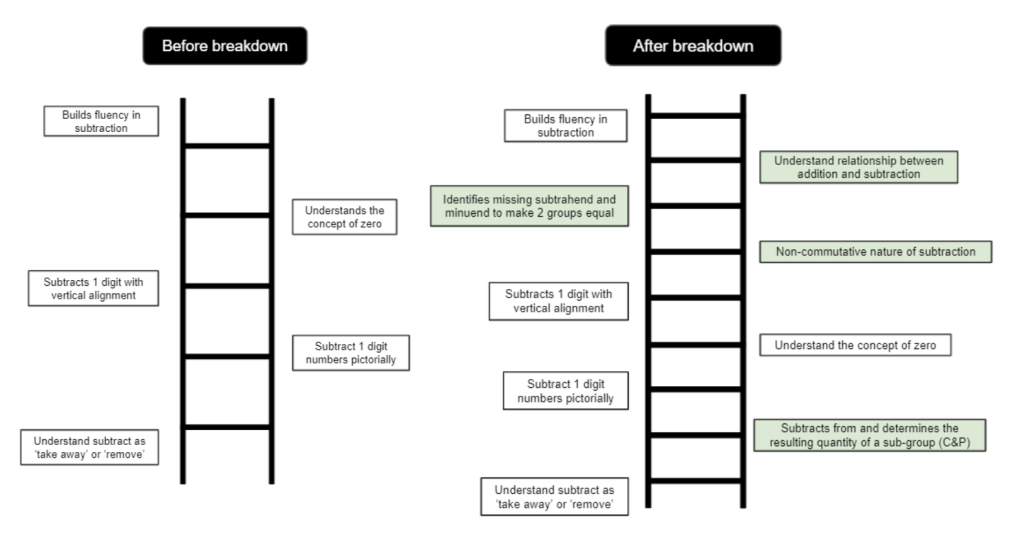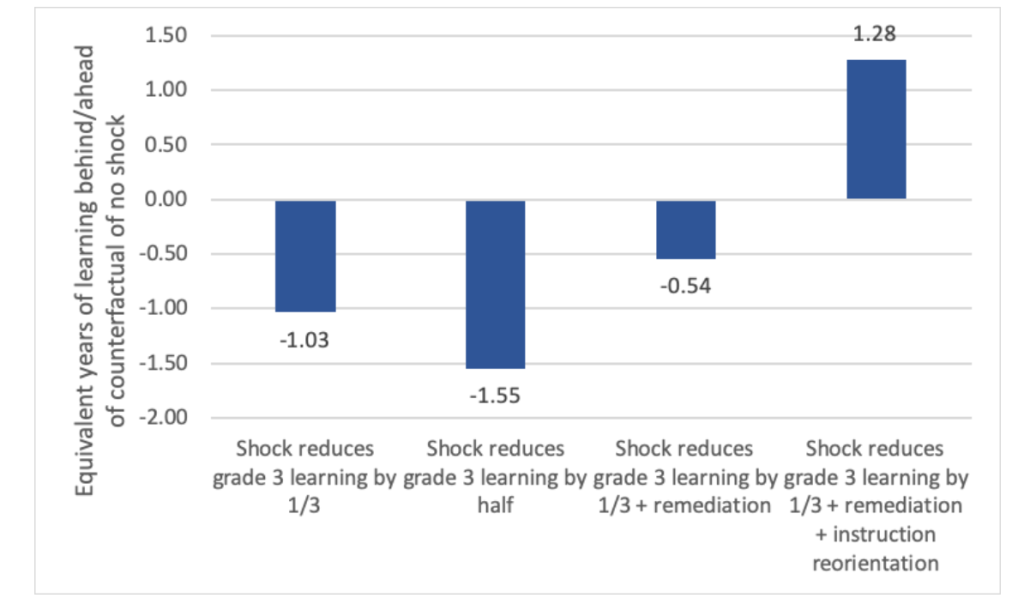Re-visiting the ‘what’ and ‘how’ of educating children during and after the pandemic
Children in our country are not learning. The National Education Policy 2020 states that even before the pandemic, more than 50 million primary grade children in India struggled to read simple texts or do basic math. The learning crisis has only worsened with schooling disrupted for as many as 250 million children across the country due to Covid-19. For a year of school closures, children currently in Grade 3 will be almost 3 years behind from where they could have been when they reach grade 10, had the pandemic not happened[1]

Where does the problem lie?
Historically, the curriculum in our country has been overambitious, and children failed to cover it even during normal times[2]. This leads to low rates of achievement of foundational skills and the gap only widens as students progress through higher grades, resulting in dropouts or students graduating without attaining mastery of basics. Even though the RTE mandates 220 days of instruction in a normal year, a 2015-16 study reveals that teachers spend only 19.1% of this time teaching[3] due to being burdened by additional non-teaching work. This further reduces the time available for completing the existing curriculum, almost turning it into a checklist exercise as opposed to helping children learn more meaningfully.
As schools reopen across India, there is a possibility of instructional time being further reduced due to unforeseen future disruptions and rotational attendance. With students now losing almost two years of schooling, there is a pressure to accelerate learning and help students ‘catch up’ with grade-level outcomes. Unfortunately, this could result in packing up two years’ worth of learning into a short-term remediation program which might not be a sustainable solution.
Even though the RTE mandates 220 days of instruction in a normal year, a 2015-16 study reveals that teachers spend only 19.1% of this time teaching[4] due to being burdened by additional non-teaching work. This further reduces the time available for completing the existing curriculum, almost turning it into a checklist exercise as opposed to helping children learn more meaningfully.
Why short-term remediation is not the answer
A child’s working memory is like a funnel, with the stem growing narrower due to a lack of structured learning and social interactions during the pandemic. Compressing two years’ worth of learning in a short span will only break this funnel. We need to slow down the pace of learning so as to not overwhelm children as they return to school, and prioritize learning only crucial things and learning them well. The pandemic has affected children differently, and we need to be cognizant of the fact that coming to school is not routine for them anymore.
How do we teach less?
Curriculum designers must prioritize learning outcomes that are essential for a child’s learning in the future and accordingly redesign the curriculum. This will enable teachers and students to focus on fundamental skills for each grade and reduce the pressure on teachers to complete the curriculum in a compressed time frame. Additionally, and most importantly, learning must be spread over the next few years to give children time to catch up with missed and forgotten learning.
The Accelerated Education Working group (AEWG) recommends three guiding principles[4] to condense a curriculum:
- Endurance: focus on knowledge and skills that learners will need throughout their lives
- Leverage: focus on knowledge and skills that can be used across multiple subject areas
- Academic Significance: focus on knowledge and skills learners need to be successful in the next level of instruction
How Vikramshila-CSF taught less and taught well: Case Study in Numeracy from Uttar Pradesh
These principles were put into action by the Vikramshila Education Society in partnership with Central Square Foundation (CSF) to identify what learning outcomes should be prioritized in numeracy for grades 1-3 in Uttar Pradesh.
The first step involved breaking down the existing learning outcomes into ‘highly targeted’ learning objectives that can be taught in one or two 40 minute long instructional periods. This helps identify the steps needed to achieve the targeted learning outcomes and promotes depth of understanding.

Based on the total available instructional time, the targeted learning objectives were then prioritized in four different ways:
- Excluding outcomes that are non-critical: Learning outcomes that are fundamental to the current grade can be prioritized over the learning outcomes that are taught in isolation in the next grade.
e.g.: ‘Measurement of length using standard units’ deprioritized for grade 2 and moved to grade 3 - Reducing the overall rigor of a learning outcome: Prioritization can be done by reducing the range/limit of the numbers that students work with, focusing on mastery within the range rather than exposure to a larger range.
e.g.: Students works with 2-digit numbers in Number Sense & Operations instead of 3-digit numbers in grade 3 - Merging the range of numbers students work within a learning outcome: While including the learning outcomes from a lower grade level is essential to ensure students have a conceptual understanding of critical topics, they can be taught in an accelerated manner by merging a range of numbers.
e.g: grade 2 students begin number recognition and counting from 1-20 instead of 1-5 - Merging of learning outcomes in application & practice: Opportunities where learning outcomes can be mapped across domains can be taken advantage of. Instances where students practice skills using concepts of money, length, capacity or measurement, can be merged with learning outcomes dedicated to practising operations. This would also provide students a good opportunity of mixed practice and create lasting connections across topics.
e.g: learning outcomes on word problems for operations and word problems for money are merged.
This exercise helped the curriculum designers reduce the total number of core learning outcomes in each grade by roughly 50% without compromising on fundamental learning. The entire curriculum for the grade can be covered in 100 days including time for revision which makes it much more feasible in the current context.
How do we teach well?
Identifying what to teach is only half the battle won. In order to teach well, it is important to regularly assess children and identify their learning levels. Teachers can use information from assessments to modify their instruction according to the needs of the children.
Following is an illustration of the weekly learning structure designed by the curriculum team at Vikramshila Education Resource Society (VERS) to help teachers constantly identify how much children have learned and subsequently, remediate accordingly. The structure gives adequate time to children to practice what they have learned, moving away from curriculum completion to actual learning.

Identifying what to teach is only half the battle won. In order to teach well, it is important to regularly assess children and identify their learning levels. Teachers can use information from assessments to modify their instruction according to the needs of the children.
What does this mean for the future?
Few experts believe that restructuring the curriculum will lead to children missing out on critical learning. But the current pace of our curriculum has anyway left almost half of our children behind[6]. We need to reevaluate what is actually worth learning and go deep into that to ensure all children are able to learn and learn well.

Few experts believe that restructuring the curriculum will lead to children missing out on critical learning. But the current pace of our curriculum has anyway left almost half of our children behind[6]. We need to reevaluate what is actually worth learning and go deep into that to ensure all children are able to learn and learn well.
The solution to learning loss and helping children catch up is not compressing the curriculum to a remediation program of a couple of months. The pandemic has presented us with an opportunity to step back and think about how we educate our children. A restructured curriculum to mitigate the learning loss could serve as a benchmark for the future of our education system; a system that recognizes the needs of every child and helps them learn at their pace.
(Credits to Vikramshila Education Resource Society[7] for their framework.)



